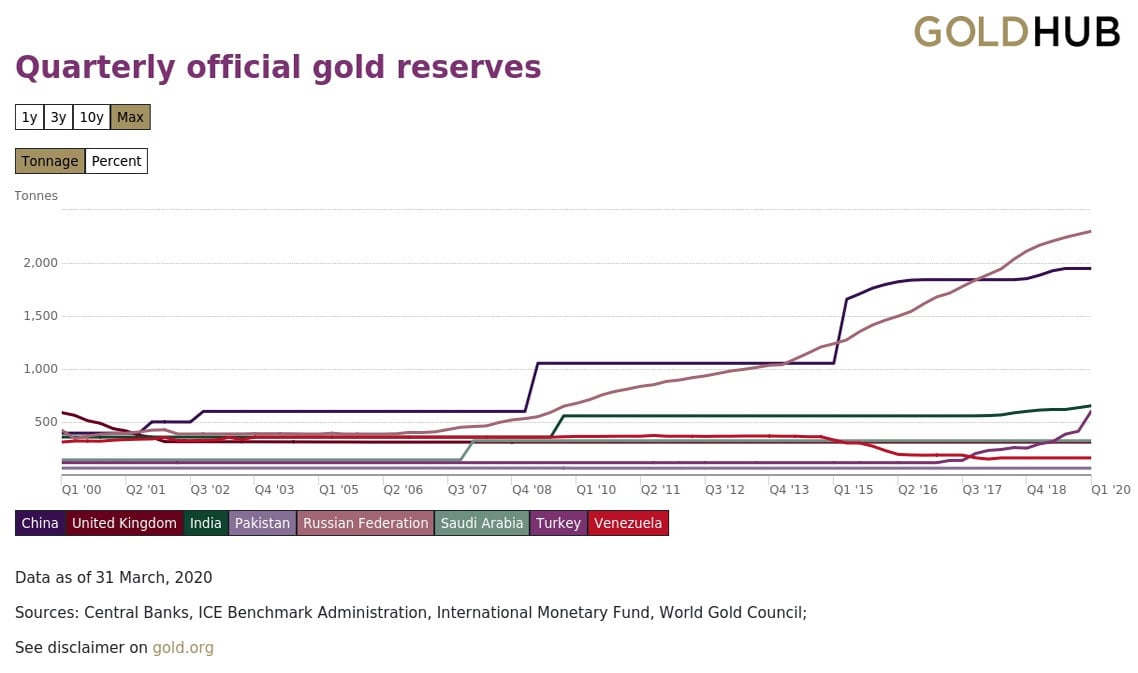How has the world responded to coronavirus pandemic through gold reserves? (24 July 2020)
As coronavirus pandemic continues around the world, infecting upwards of 15 million people and killing over 632,000, Geo.tv looks at the positions various countries have taken in terms of increasing or decreasing their gold reserves.
Before going into the data, it is important to remember that the yellow metal is viewed as a safe bet during crises and, therefore, centrals banks around the world added 650 tonnes of gold to their reserves over the past one year.
The high value — which may differ in June 2020 statistics — reflects the seriousness of the coronavirus pandemic.
Why do central banks keep gold reserves? Because bullion is relatively safe to invest in as it can withstand political or economic changes better compared to other metals, currencies, and stocks. It is also more liquid, thereby allowing countries to convert it to cash should the need arise.
Gold rates have also been on a persistent rally since quite a while, reaching new levels and even breaking past the nine-year high earlier. In Pakistan, earlier today, gold shot up to an all-time high of Rs117,300 a tola, whereas the price of 10 grammes rose Rs1,972 to Rs100,566.
Globally, the gold rates have gone up to $26 an ounce to almost $1,882. The precious metal has been staying above $1,800 in the global markets — close to nearly the nine-year peak hit in the previous session — as fears of economic stagnation grew owing to the skyrocketing coronavirus cases.
On a year-to-date (YTD) basis, only two central banks — that of Turkey and Uzbekistan — have bumped up their reserves significantly, by 36.8 tonnes and 6.8 tonnes, respectively, according to the data from the International Monetary Fund (IMF) and published on the World Gold Council's (WGC) website.
"In May, only Mongolia saw their gold reserves decline significantly, by 3.3t. On a y-t-d basis, six central banks have now decreased their gold reserves, totalling 31.8t," it says.

According to the WGC's mid-year outlook 2020, gold has had "a remarkable performance, increasing by 16.8% in US-dollar terms and significantly outperforming all other major asset classes".
"By the end of June, it was trading at US $1,770/oz, a level unseen since 2012," the international body notes.
Data from the WGC shows that as of March 31, 2020, and June 2020 for the countries that reported second-quarter figures as well, the situation of reserves around the world is as follows:
• US: 8,133 tonnes (highest in world; majority or 79% of foreign reserves)
• Russia: 2,299 tonnes (22.6% of its foreign reserves)
• China: 1,948 tonnes (3.1% of its foreign reserves)
• India: 654 tonnes (7.5% of its foreign reserves)
• Turkey: 601 tonnes
• Uzbekistan: 338 tonnes
• Saudi Arabia: 323 tonnes
• UK: 310 tonnes
• Venezuela: 161 tonnes
• Pakistan: 65 tonnes
As per a report in TRT World, Turkey’s Central Bank has purchased 148 tonnes since the start of this year, making it the biggest gold buyer.
#AhmedShameel #AhmedShameelNews



Comments
Post a Comment